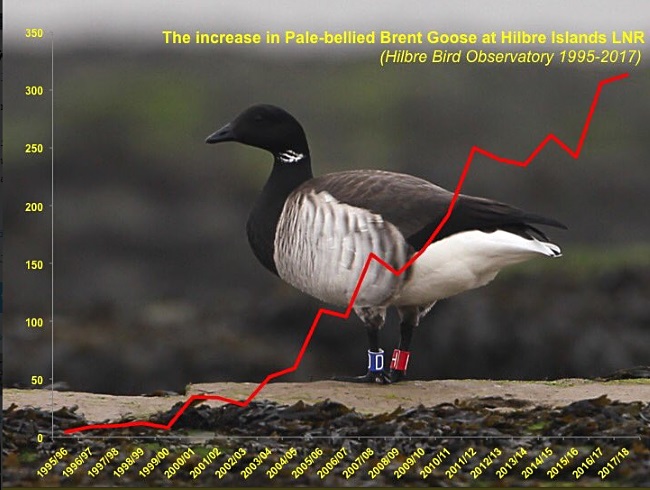Site menu:
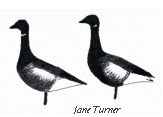
December 2017 Newsletter
Pallid Harrier on the Dee estuary.
New WhatsApp Wirral Birders Group.
Colour Ring Report.
November Bird News.
Forthcoming Events.
Latest Newsletter.
Pallid Harrier on the Dee estuary
A first first for Cheshire
Below is
Phil Woollen's account of the Pallid Harrier which visited the Dee
estuary marshes, first spotted towards the end of September 2017 and it
gave particularly good views from September 29th to October 1st. The
account is taken from Phil's A
Wirral Birders Blog.
Quite correctly, Phil headed his account with 'potentially a 1st for Cheshire' as it has
not yet been accepted, but there seems little doubt it will be.
Pallid harrier is one of those rarities that seem to have got commoner over the last decade as they've increased their breeding range westwards into Finland. A pair also bred for the 1st time in Holland this year and there was a long staying male displaying at Bowland. With a winter harrier roost off Parkgate Old Baths we've been hoping for a Pallid Harrier for some time - especially as their now almost expected on our annual Shetland jaunt. The 1st one I ever saw was when I was working in Finland in 1983 when it was still scarce over there and I twitched it with a mad group of Finnish birders. The first UK one I saw was the juvenile at Winterton, Norfolk in June 2006 - I took a very young Dan Pointon along with me! Photo of this bird I took is below:
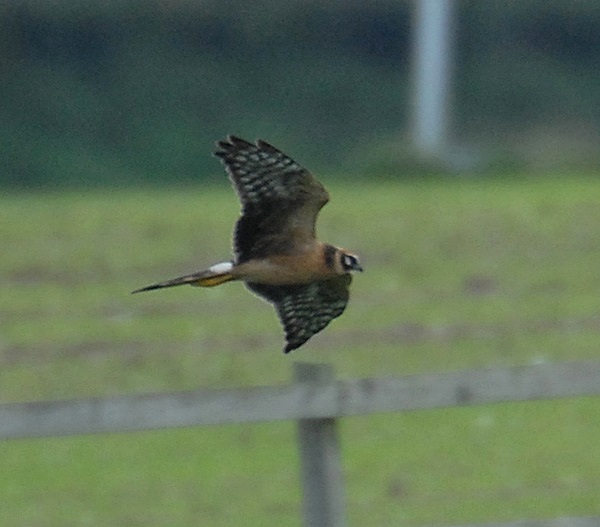
When Alan Davies reported he'd seen an
interesting, small, long winged harrier distantly on the Dee estuary
last week my interest was aroused. Unfortunately I couldn't get down
during the week and after a few days with no news it was temporarily
forgotten. Until the weekend............
Independently both Eddie Williams and Mark Garner saw it and both
confirmed it was a Pallid Harrier. Mark P arranged to come to our house
and we travelled the short distance to the marshes in pouring rain to
find we'd just missed the harrier by a few minutes! It was quite a
social gathering of Cheshire & Wirral's finest waiting
patiently in the pouring rain. At this point the bird was tentatively
being aged as an adult female, not a juvenile, and to make things even
more confusing there was a ring-tailed Hen Harrier in the same location
that some people were watching whilst others were watching the Pallid
Harrier! It didn't help when people claimed they'd seen it then asked
what it looked like and what the identifying features were. No wonder
the bird information services got their undies in a twist on the Sunday
and were putting out Pallid / Hen Harrier!
After a long wait the bird appeared again and flew past at distance
before pitching down into the marsh where it spent the next 90 minutes
barely visible. A Hen harrier appeared and we were all watching that
and comparing diagnostic features when the Pallid decided to fly again!
This time it put on a good show to an appreciative audience and video
footage and photo's were obtained seemingly proving it was an adult
female.
Mindful of the spectre of hybridisation with Hen Harrier (common in
Finland) a great deal of attention was paid to the all important wing
formula. Jack Ashton Booth's blog was great help in this respect:
http://raptor-id.blogspot.co.uk/2017/06/harrier-hack-1.html?m=0
A bird we also saw at Loch Hillwell, Shetland, that had been apparently
oiled by a Fulmar also caused a lot of discussion at the time. See here:
http://birdingfrontiers.com/2011/10/13/juvenile-pallid-harrier-identification/
Overall we were happy it was a sub adult female rather than a juvenile.
I didn't take my camera with me because of the pouring rain. Luckily Simon
Slade was braver than me and took the pictures below.
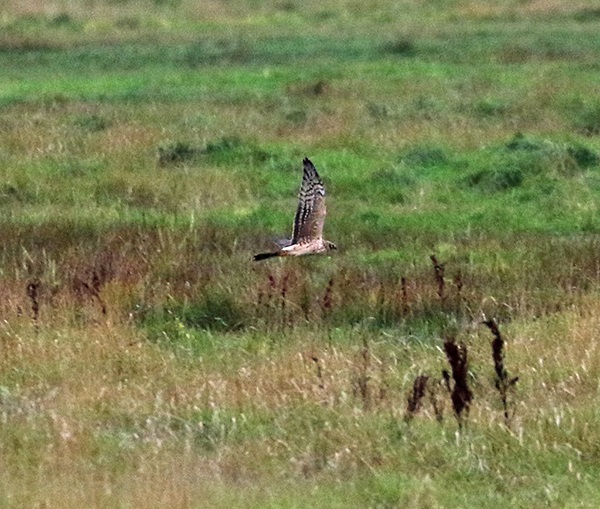
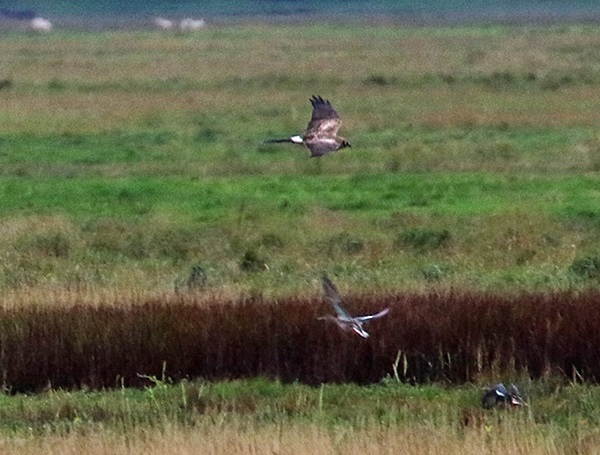
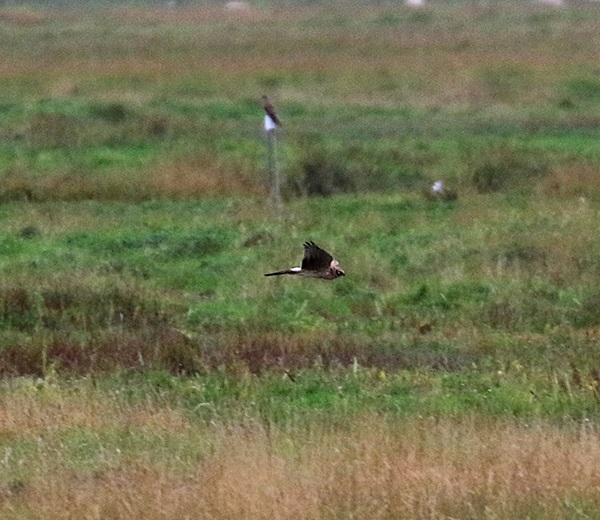
A great afternoons birding with great company, a good craic, some good discussion and some good birds. As well as the Pallid Harrier there was a supporting cast of 3 Short-eared Owls (all in the air together), Hen Harrier, at least 3 different Marsh Harriers, Sparrowhawk, Merlin, Peregrine and Kestrel as well as at least 2 Great-white Egrets (seen together).
Phil Woollen (2nd October 2017).A Wirral Birders Blog: https://wirralbirders.blogspot.co.uk/2017/10/pallid-harrier-on-dee-estuary.html
Top of Page
WhatsApp Wirral Birding Group
A WhatsApp group has been set up to allow Wirral Birders to share their bird news for the area. The advantages of having access to this WhatsApp group over the likes of Twitter & Facebook are that everyone can send out their own news without having to go through a central person, and when a message is sent out everyone will see it, unlike Twitter & Facebook where news is easily missed.
To join, and for more details, see:https://elliotsbirdingdiaries.wordpress.com/2017/11/24/whatsapp-wirral-birders/

Colour Ring Report

One of the benefits of colour ringing birds is to show just how site
faithful they are, not just in the breeding season but also both during
passage and on their wintering grounds. The pontoons on West Kirby
Marine Lake seems to be particularly attractive to colour-ringed
Black-headed Gulls and we've had four there over the past few weeks
which we've recorded in previous years. A few years ago we appeared to
have several colour-ringed Mediterranean Gulls visiting us but they
seem to have dried up recently, so it was good to have another one in
November with an interesting history.
As expected, the Black-tailed Godwits stopped using their inland roost
site at Caldy at the end of October and we know many ended up north of
us at Marshside (Southport). But it has also been obvious that there
was an influx of birds from south-east England, both the Wash and
Thames estuary. Of the 22 birds we recorded during October and November
(and for which we've received feedback) exactly half had spent late
summer and early autumn on the south-east coast.
We continue to see good numbers of colour ringed Knots and I will be
going into more detail about those next month.
Black-headed Gulls
TMEN
(black on white ring)
Ringed near Lodz, Poland, on 12th April 2013.
Recorded at West Kirby Marine Lake on September 19th 2017.
This bird was first seen on the pontoon at West Kirby Marine Lake on
6th September 2013 and a further 30 times since then. The only other
records for this bird was on the sand at West Kirby in July 2014 and at
Hoylake in November 2014.
Ringed at Bowness in Cumbria on January 1st 2015, and recorded there in August and October 2015.
Since then it has only been recorded on pontoon at West Kirby Marine Lake, a total of 11 times. First record was on 29th January 2016 and latest record was on 21st November 2017.
Mediterranean Gull
AEKL (white on green ring)Ringed on Pionierinsel island, Elbe estuary, on May 24th 2008, as a nesting adult.
Recorded on Hoylake Shore on 3rd November 2017.
It was back on the Elbe estuary in spring 2009 but the following winter it flew west, being seen at Seaforth (Mersey) in February. In 2009 it switched breeding sites and was recorded in Zeeland, Netherlands. It was back at Seaforth the following winter and switched breeding sites again, this time just over the border near Antwerp in 2012. In 2013 it was back in Zeeland, Netherlands, but then disappeared before turning up at Hoylake in November 2017.
Black-tailed Godwits
GO-LLflag - ringed in north Iceland on 18th July 2006, as a chick.Recorded on West Kirby Shore on 11th
August 2017 then eight times in the same month roosting at Caldy
Wildfowl Collection. It was on the Ribble estuary (Lytham) at the end
of August then at Marshside RSPB, Southport, at the end of October 2017.
After ringing this bird wasn't seen until early 2011 when it turned up
at Marshside. The large majority of records are during late
summer/autumn and again in early spring - all either at Marshside or
Leighton Moss. So we do not know where this bird spends the winter. It
has been seen once back in Iceland, presumably breeding, in July 2013.
YGR-RNR
- ringed on the Swale estuary, Kent, on 12th October
2015, as an adult.
Recorded at Caldy Wildfowl Collection on 9th October 2017, it then flew
to Marshside RSPB, Southport, where it was seen at least twice during
the rest of October.
Since it was ringed nearly all records are from the Oare Marshes Nature
Reserve, Kent, where it spent it's summer/autumn moult both in 2016 and
2017. It was at Marshside on 5th November 2016 but back in Kent the
following month.
Richard
Smith.
Colour-rings were also recorded by Steve Hinde, Matt
Thomas, Peter Haslem, Derek Bates, Mark Turner, Colin
Schofield and Charles Farnell.
November Bird News
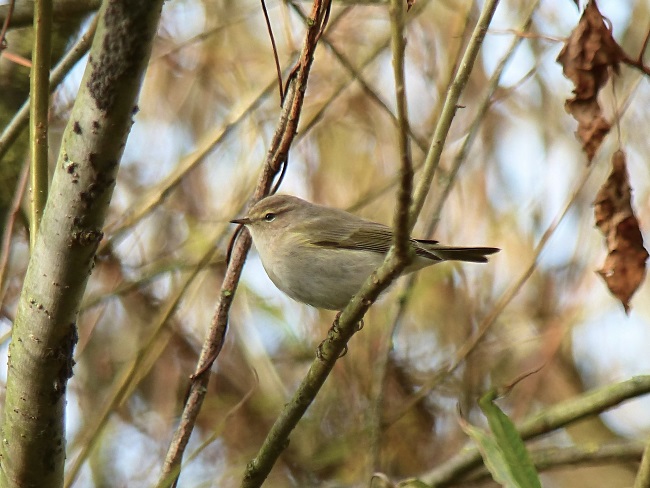
There was a record influx of Hawfinches into the country at the end of
October and into November - and we had our share with five at
Burton Mere Wetlands on the 8th, with more further inland in Cheshire.
A Siberian Chiffchaff was a good find by Leasowe Lighthouse and this
was recorded on several days early in the month. Two Snow Buntings were
in Leasowe Bay and a Black Redstart was spotted on a couple of days in
Hoylake. Somewhat more numerous was a roost of 85,000 Starlings in the
reed bed at Gronant.
Out to sea was a rare Little Auk which
flew past Hilbre on the 18th, whilst early in the month was a total of
20,000 Common Scoter and 18 Red-throated Diver, a flock of up to 12
Eider stayed all month.
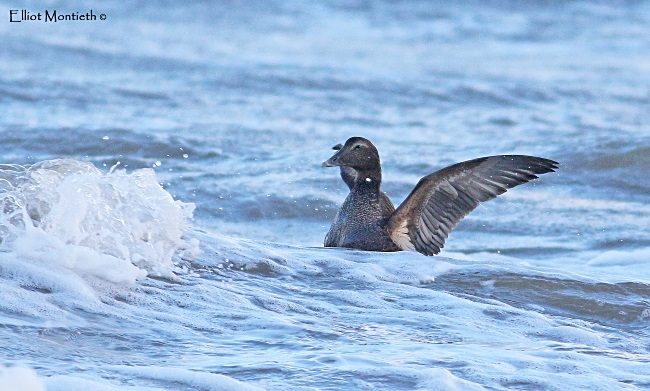
https://elliotsbirdingdiaries.wordpress.com/
Marsh Harriers will feature in next month's newsletter but the roost at Neston Reedbed is now well established with numbers well into double figures. There appears to be two grey male Hen Harriers and at least two ringtails on the marshes and the highest count of Short-eared Owls was seven. 12 Great White Egrets were between Parkgate and Burton on the 5th.
November 23rd was a late date to have 11 Greenshank at Connah's Quay, where there was also nine Spotted Redshanks, a Common Sandpiper and an Avocet.
337 Brent Geese were off West Kirby at high tide on the 20th, one of
the highest counts ever - these lovely geese are obviously increasing
again after remaining at around the 250 level for several years. At
least 5,000 Pink-footed Geese are in the area. More unexpected were
nine Greenland White-fronted Geese at Warren Farm, Talacre, for several
days.

Top of Page
What to expect in December
There are some nice big tides early in the month, if they are blown in by strong west winds we can get spectacular views of thousands of wildfowl and waders over the marshes, plus Short-eared Owls and Hen and Marsh Harriers.
We've already had good numbers of Brent Geese arriving and the trend over the past couple of winters is for some of them to disperse away from Hilbre - so we can expect them on West Kirby Marine Lake feeding on the wall by the prom, and also near the causeway at Thurstaston, seemingly unconcerned by the dog walkers on the beach. Thurstaston is also the best place to see that lovely duck, the Pintail, probably best about two hours either before or after high tide and they often congregate at the stream coming from Tinkers Dell where they gather for a drink of fresh water; we've had increasing numbers over the past three or four winters with up to 2,000. This is also a good spot to see Teal feeding on the mud when the tide is out.
Other wildfowl to look out for are Pink-footed Geese on the marshes, Red-breasted Mergansers on West Kirby Marine Lake and Scaup off Hilbre and north Wirral.
Connah's Quay Nature Reserve has become one of the most important wintering sites for Twite in the north-west of England and numbers have reached 200 here in the past couple of years. Look out also for Snow Buntings, never very common here but we can get one or two along north Wirral and Hilbre, with may be a small flock of six or so at Point of Ayr and Gronant.

Top of Page
Forthcoming Events
December Highest Spring Tides (Liverpool)
Also
see Tides
page.
4th December, 11.09hrs (GMT), 9.9m.
5th December, 11.55hrs (GMT), 9.9m.
6th December, 12.43hrs (GMT), 9.8m.
Forthcoming Events
Organised by the Wirral
Ranger Service , Flintshire
Countryside Service and the
RSPB (Dee Estuary):
All these events and walks have bird interest, even those not
advertised specifically for birdwatching. No need to book for these
events unless specified - please check below.
8.30-10.30am
Price: £8 per person (RSPB members £6.50)
Booking essential, ring: 0151 353 8478.
The UK's wetlands are a vital winter home for thousands of wading birds and wildfowl, and the Dee Estuary is one of the best places in the country to see them. Join an experienced guide for a morning walk around Burton Mere Wetlands to brush up on your ID of the various waders, ducks, geese and swans that spend the winter here.
There's also a great chance of seeing a range of birds of prey including harriers and peregrines, plus impressive flocks of finches and buntings in the sacrificial crop fields, whilst kingfishers have been very active this autumn.
The walk will stick to the reserve's normal trails which are mostly hard-surfaced, but the outer reaches of the reserve have natural paths and a couple of sets of steps to reach the Inner Marsh Farm hide. Warm up back at the Reception Hide with a hot drink and a chance to see what may have been pushed in from the saltmarsh by the rising tide.
Tuesday 12th
December, Dusk Chorus at Burton
Mere Wetlands.
2-4pm
Price: £8 per person (RSPB members £6.50)
Booking essential,
ring: 0151 353 8478.
We're
all familiar with the dawn chorus, but have you ever stopped to listen
to the sounds of the countryside as the sun goes down? Honking geese,
whistling waders and chattering jackdaws soundtrack peaceful sunsets at
Burton Mere Wetlands, with one of the country's largest egret colonies
returning from the marsh, and a small starling murmuration over the
reedbed.
Join us for a late afternoon guided walk as the
temperature drops and the birds start to prepare for another long
night, returning as the light fades and many birds return to Burton
Mere Wetlands to roost. Finish with a hot drink back in Reception Hide
and chance of seeing a barn owl emerging to hunt.
Places are limited, so
advanced booking and payment are essential.
Sunday 14th
January, Big Farmland Bird Walk at Burton
Mere Wetlands.
8-10am.
Price: £10 per person (£8 RSPB members)
Booking essential,
ring: 0151 353 8478.
Join us on this exclusive early morning, behind-the-scenes walk to get
closer to the managed farmland parts of the reserve and hopefully find
a range of songbirds alongside large flocks of others you might see on
your Big Garden Birdwatch.
Large flocks of small farmland birds - particularly linnets and reed
buntings - feed on our bird cover crop, along with flocks of gold and
greenfinches and other more familiar garden birds. These in turn
attract merlins, sparrowhawks and hen harriers to hunt.
The nearby wet pasture and barley stubble offer excellent natural
grazing for the geese and swans spending the winter on the estuary and
this walk should provide closer views particularly of the swan flock on
the neighbouring Shotwick Fields.
Please note this event is weather-dependent. A cold, hard winter will
push more birds to the west coast, so we'll keep our fingers crossed!
Wear wellies and warm, waterproof clothing, and bring binoculars if you
have them. Price includes a hot drink in the Reception Hide afterwards.
Places are limited so advanced booking and payment are essential.
